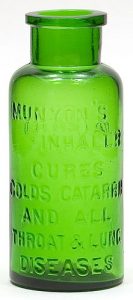Victorian
Tuna – a vegetable compound
There’s often something a bit fishy about patent remedies, but this one appeared before the advent of canned tuna and, for the average non-sea-going punter, the name did not have the piscatorial associations it has now. A company called Fels and Davis began promoting it in 1879, but by the following year Davis had quietly disappeared […]
Read MoreSago Jenkinson and the Case of the Witched Child
When Nancy Harborough took her sick child to a local celebrity doctor in 1844, she probably didn’t expect to receive advice worthy of Matthew Hopkins two centuries earlier. As it was, the whole sad episode ended up in court, and as the Hull Packet put it: The facts of the case speak but little indeed […]
Read MoreSmith’s Live-Long Candy
Sometimes, patent remedies killed people. The Live-Long Candy did manage to get mentioned at an inquest, and there’d be a particular irony in a product of this name carrying someone off – but I reckon it’s innocent. Eight months before this ad appeared, 16-year-old Belinda Balls, housemaid to Mrs Waspe at Gusford Hall in Suffolk, […]
Read MoreSequah – a Victorian Celebrity Quack
Source: The Graphic 11 July 1891 . From the moment of his sudden rise to fame in Portsmouth in 1887, Sequah knew how to win friends and influence people. He built up an almost cult-like following by giving the crowds what they wanted – miraculous cures, affordable medicines, and a lot of Wild West-style entertainment. Handbills […]
Read MorePaul Gage’s Tonic Antiphlegmatic Elixir
Source: The Liverpool Mercury, 30 December 1851 . Phlegm is generally white, greyish, or of a yellow colour, with streaks of black; its consistency varies from the limpidity of water to the thickness of jelly. This vivid description is from Parisian chemist Paul Gage’s Treatise on the Effect and Disorders produced by Phlegm in the […]
Read MoreThe Invisible Elevators for Short People
From The Standard (London) 10 April 1897 . Perhaps this is not strictly medical, but I noticed this ad while researching something else, and was intrigued enough to find out more. The invisible elevators, I discovered, were cork wedges about 1 inch thick, designed to be worn inside your shoes. The image below is of […]
Read More‘Like a half-felled cow’ – a case of arsenic poisoning in Victorian Scotland
When you’re under the weather and you Google your symptoms in an attempt to convince yourself that you are about to die, spare a thought for Jean Landess, whose perusal of Chambers’s Encyclopaedia was the beginning of a tragic chain of events. In May 1868, 39-year-old Mrs Landess, of Paisley, had just weaned her youngest […]
Read MoreAtkinson & Barker’s Royal Infants’ Preservative
Source: The Patriot (London) 12 September 1853 It is no misnomer Cordial! —no stupefactive, deadly narcotic! —but a veritable preservative of Infants! Regular readers of The Quack Doctor might be able to hazard a guess at the active ingredients of this product. Like other infant quieteners, it did contain a narcotic, and, like them, it […]
Read More
Munyon is ready…
Would you buy a homeopathic remedy from this man? Source: The Morning Times (Washington D.C.) 13 December 1896 James Monroe Munyon’s pompadour hairstyle was a familiar feature of American newspapers around the turn of the 20th century. Having tried his hand at teaching, law, social work, publishing and song-writing, he started his Homoeopathic Home Remedy […]
Read More